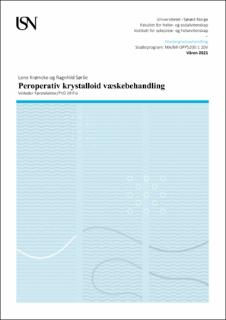| dc.contributor.advisor | Flo, Jill | |
| dc.contributor.author | Krømcke, Lene | |
| dc.contributor.author | Sørlie, Ragnhild | |
| dc.date.accessioned | 2021-11-23T17:41:38Z | |
| dc.date.available | 2021-11-23T17:41:38Z | |
| dc.date.issued | 2021 | |
| dc.identifier | no.usn:wiseflow:2539282:41724586 | |
| dc.identifier.uri | https://hdl.handle.net/11250/2831104 | |
| dc.description.abstract | Bakgrunn: Peroperativ væskebehandling er et omdiskutert tema og ulike strategier for behandling av den kirurgiske pasienten har gjennomgått store endringer de siste tiårene.
Hensikt: Å kartlegge peroperativ væskebehandling til ortopediske pasienter ved et sykehus i Sør-Øst Norge, og sammenligne funn med gjeldende anbefalinger for å kvalitetssikre praksis som utføres på anestesiavdelingen ved dette sykehuset.
Metode: Studien er gjennomført som en singel-senter kvalitetssikringsstudie med et kvantitativt retrospektiv design. Av 379 pasientjournaler som er gjennomgått er det 150 pasienter som har blitt inkludert i studien. Utvalget er voksne pasienter i ASA-klasse I eller II.
Resultat: Peroperativ væskebehandling til ortopediske pasienter ved dette sykehuset varierer stort (SD-avvik 70). Det blir administrert alt fra 100-3600ml krystalloid væske i løpet av ett kirurgisk forløp. Pasientene fikk i median 6ml/kg/t med en variasjon fra 1-40ml/kg/t. Det totale volumet som ble administrert varierte mellom ulike kirurgityper, og det er mange faktorer som kan påvirke peroperativ væskebehandling. Det ble funnet at det totale volumet administrert peroperativt økte med økende alder. Det ble ikke funnet en sammenheng mellom peroperativ væskebehandling og hypotensjonstid.
Konklusjon: Det kan ikke konkluderes med om funnene i denne studien er i tråd med dagens anbefalinger. Resultatene av studien viser at kun 1% av utvalget har fått overdreven væskebehandling. Mulige områder for forbedring i forbindelse med peroperativ væskebehandling er økt fokus på journalføring og implementering av væskebolusfunksjon i anestesijournalen. Det bør utarbeides nye retningsgivende prosedyrer for anestesisykepleiere som bygger på nyere forskning og dagens anbefalinger, og væskebehandlingsstrategi bør baseres på kirurgisk risikoprofil og helsetilstand hos den enkelte pasienten.
Nøkkelord: peroperativ væskebehandling, peroperativ sykepleie, intravenøs væskebehandling, krystalloid væskebehandling, peroperativ, anestesisykepleie, kunnskapsbasert praksis. | |
| dc.description.abstract | Background: During the last decade intraoperative fluid management has been up for debate and various strategies have undergone major changes.
Purpose: To map intraoperative fluid treatment for orthopedic patients at a Hospital in Norway, and compare findings with current recommendations for quality-assured practices performed at the anesthesia department in this Hospital.
Method: The study was conducted as a single-center quality assurance study with a quantitative retrospective design. Within the 379 patient records reviewed, 150 patients were included in the study. The patients included in the study are adults an ASA score of I or II.
Results: Intraoperative fluid treatment for orthopedic patients at this Hospital varies greatly (SD deviation 70), with volumes ranging from 100-3600ml of crystalloid fluid administered during a surgical procedure. The patients received a median of 6ml/kg/h with a variation of 1-40ml/kg/h. The total volume administered varied dependent on the different types of surgery, and we find that there are many factors that can affect intraoperative fluid therapy. It was found that the total volume administered intraoperatively increased with increasing age. No association was discovered between intraoperative fluid therapy and hypotension time.
Conclusion: It cannot be concluded whether the results of this study are in line with current recommendations or not. The results of this study shows that 1% of the patients have been treated with excessive fluid therapy. Possible areas for improvement connected with intraoperative fluid treatment are increased focus on record keeping and implementation of fluid bolus function in the anesthesia journal. New guiding procedures should be developed for nurse anesthetists based on recent research and current recommendations, and fluid treatment strategies should be based on the surgical risk profile and state of health of the individual patient.
Keywords: intraoperative fluid management, intraoperative nursing, intravenous fluid administration, crystalloid fluid administration, nurse anesthetists, evidence-based nursing. | |
| dc.language | nob | |
| dc.publisher | University of South-Eastern Norway | |
| dc.title | Peroperativ krystalloid væskebehandling | |
| dc.type | Master thesis | |
